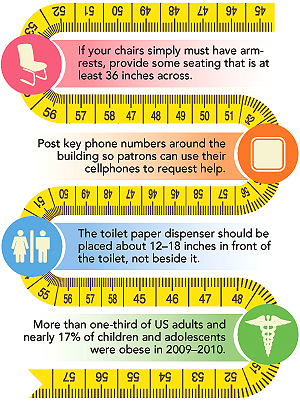Most libraries are conscientious about providing accessible facilities and services tailored to specific populations, yet some forget the needs of their plus-size patrons.
 More than one-third of US adults and nearly 17% of children and adolescents were obese in 2009–2010, according to a January 2012 data brief from the Centers for Disease Control and Prevention’s National Center for Health Statistics. Those numbers mean that every public service facility in the country—including libraries—should be prepared to meet the needs of plus-size patrons.
More than one-third of US adults and nearly 17% of children and adolescents were obese in 2009–2010, according to a January 2012 data brief from the Centers for Disease Control and Prevention’s National Center for Health Statistics. Those numbers mean that every public service facility in the country—including libraries—should be prepared to meet the needs of plus-size patrons.
A few simple changes might make all the difference to an obese person’s experiences as a user of your library. You may not be able to implement these changes immediately, but you should keep them in mind if you’ll be building a new library or renovating an existing one.
For me, the problems discussed below are not theoretical. As a, let’s say, “generously proportioned librarian” who has encountered obstacles in all types of public facilities, I base many of these recommendations on my own experiences.
Seating
Narrow chairs with fixed armrests are the natural enemy of the obese. If we don’t fit, we can’t sit. Molded plastic chairs aren’t much better. To be comfortable, a large person needs a sturdy, wide seating surface. A cushioned surface is preferable, but a hard one is fine as well. Couches, love seats, and benches are all good choices. Chairs are fine, but avoid those with armrests. If your chairs simply must have them, provide matching chairs in a variety of widths, including some that are at least 36 inches across. This seems to be the current trend in many hospitals and physicians’ waiting rooms. An online search for “bariatric chairs” will turn up several examples.
Ensure that seating areas are evenly distributed around the building for those patrons who can’t walk great distances without resting.
If your library has classrooms, avoid at all costs the chair/desk combination in which the desk is attached to one arm of the chair. Chairs and desks should be separate pieces so that a chair can be moved to a comfortable distance from a desk. If possible, try to leave plenty of room between your rows of desks.
Booths, too, can be problematic. If you have booths, ensure that tables are not affixed to the floor or wall but can be repositioned in relation to seats. Auditorium seats should have armrests that can be lifted completely out of the way so an individual can use more than one seat when necessary.
Don’t forget about your conference room, if you have one. Conference rooms are notorious for having chairs with fixed armrests. I’ve often had to find a friendly staff member to lend me a task chair without arms that I could use during a meeting in a nearby conference room. Thankfully I’m not the type who embarrasses easily; otherwise that sort of experience could be mortifying.
Remember that obese staff members may also need special seating. They spend more time in the library than patrons, so their comfort is imperative. However, they may be reluctant to request a larger chair because they may not yet have realized that it is an issue. Library administrators should be proactive in asking staff members if their workstations are comfortable.
Restrooms
Obese people need as much hip room as possible on both sides of the toilet, so in regular stalls the toilet should be placed in the center of the stall rather than off to one side. The toilet paper dispenser should ideally be placed about 12–18 inches in front of the toilet rather than right beside it.
The taller toilet in the handicapped stall may be easier for obese people to rise from, and the rails may be helpful as well, so many will use that stall. Commonly, there’s also more space surrounding the toilet in the handicapped stall.
When selecting a toilet, an oblong shape is a better choice than those that are smaller and rounder. Large people are not only large from side to side but front to back as well.
Health and safety
In addition to health issues such as arthritis and heart disease, many obese people perspire more easily and therefore may face the possibility of becoming dehydrated. I personally can work up a sweat by just standing still for an extended period of time. To encourage proper hydration, make sure you have water fountains and that those fountains function properly.
Are your stepstools labeled with weight limits? That sort of information may be vital to an overweight patron trying to decide between retrieving a book himself or asking for assistance. It may also become a liability for the library if the patron were to take a spill.
If an obese person (or anyone else for that matter) on an upper-level floor experiences a health emergency and has to be removed from your library on a stretcher, are your public elevators large enough to simultaneously accommodate both the stretcher and the health care personnel? If not, you may need to consider putting procedures in place that would allow emergency personnel to use your freight elevator.
Signage
For obese patrons (and others) who have trouble walking, it would be helpful to post key phone numbers around the building so they can use their cellphones to request assistance. Posting QR codes leading to pertinent information on the library’s website may also be beneficial.
Looking ahead
The obesity epidemic is unlikely to go away anytime soon. In the meantime, libraries should continue their long tradition of offering a warm, welcoming space to people of all ages, races, shapes, and sizes.
